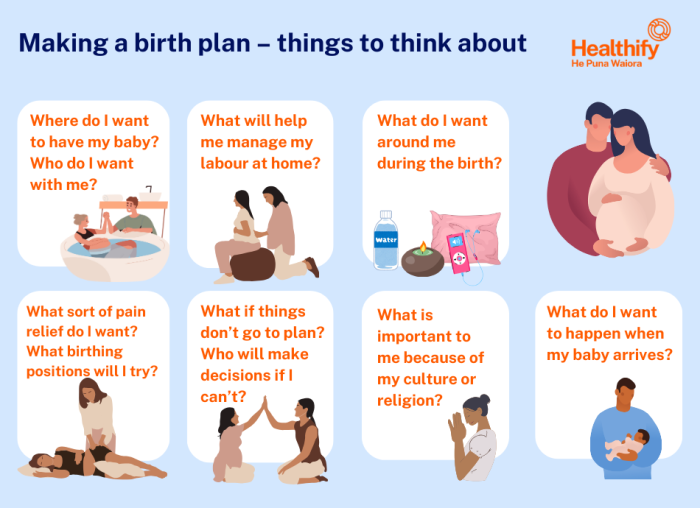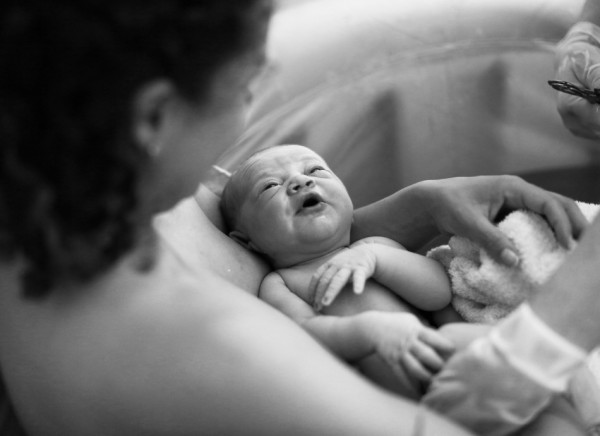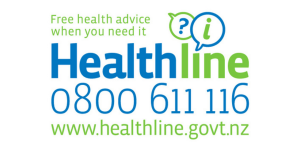Pregnancy – birth plans
Making a plan for labour and the birth of your baby
Key points about birth plans
- If you're hapū, a birth plan outlines your wishes for your labour and the birth of your baby.
- Having a birth plan makes it clear what your preferences are.
- You can change your mind about most things in your birth plan at any time.
- Although a birth plan documents what you would ideally like to happen when you give birth, it's important to be flexible on the day. Labour and birth can be unpredictable.

If you’re hapū, making a birth plan can be part of your preparation for what happens before, during and after the birth of your baby. It’s a written plan that describes your wishes for your labour and the birth of your pēpi.
Your lead maternity carer (LMC) – usually a midwife or specialist doctor – can help you make your birth plan.
It’s a good idea to have a couple of copies of your birth plan in your labour bag or have it easily accessible on a device. This could be in the form of a letter to your midwife/maternity care provider(s) that clearly outlines your preferences. If you go into labour and there are people involved in your care who haven’t met you before, your partner or support person can ask them to read this summary and then they can discuss it with you between contractions.
Other things you can do to prepare for the birth
Going to an antenatal class is a good idea. They provide lots of information about pregnancy, birth and afterwards. It’s also a good way of meeting other pregnant couples. Learning about labour, what influences it and what usually happens can help you prepare mentally, physically and emotionally. Read more about antenatal classes(external link).
It’s important to have a bag packed and ready to go with all the things you might need during the labour, birth and immediately afterwards. Remember to think about what you need for yourself, your birthing partner and your pēpi. Your LMC can advise you about what to pack and Plunket(external link) provide a list of things you might like to include. Have it ready about a month before your due date.
Check you have all the things you need for after the birth. Have you got:
- Childcare arranged for other tamariki?
- Transport to the hospital or birthing centre if you're not planning a home birth?
- A car seat or capsule properly installed in your car?
- Somewhere safe for your baby to sleep at home? (Cot, bassinet, wahakura or pēpi pod). Read more about safe sleeping for your pēpi.
- Nappies and newborn clothes?
- A few basics (loo paper, sanitary pads) and some easy meals prepared or planned?
Having a birth plan makes it clear what your preferences are. It also lets people who don’t know you well know what’s important to you. If, for example, your LMC is unable to be with you during your labour and/or birth it may be difficult to educate a new person about all the things you would like to happen – especially if you’re in the middle of active labour!
Going through the process of making a birth plan can also:
- help you understand your options for labour and birth
- get you thinking about your beliefs about birth and your hopes for your birthing experience
- give you a chance to ask any questions that come up
- help your midwife or LMC get to know your preferences
- be a good starting point for talking with your partner, friends and whānau who may be supporting you.
Having a birth plan can prompt you to make practical and mental preparations for your labour and birth so you know you’ve done all you can towards having the birth experience you hope for.

Image credit: Healthify He Puna Waiora
Below is a list of things that you can include in your birth plan. You can change your mind about most parts of it at any time.
- Where you’d like to give birth – at home, in hospital, or at a birthing centre.
- Who will support you during labour – this may be your partner, whānau or friends. Feeling safe and supported is important during labour and deciding who will support you will help the process.
- Labour will usually start at home and in most cases you'll be encouraged to stay at home as long as possible to help your labour get going. Thinking about how you will cope at home is helpful when the time comes. Strategies could include water, movement, massage, a TENS machine, acupressure and aromatherapy.
- Whether you need an interpreter or have any other special requirements.
- How you’d like the birthing room to be set up – you may be hoping to have a water birth, or you may like to have your own candles, cushions/pillows, nutritious snacks for early labour, aromatherapy or music in the room.
- Any special cultural or spiritual/religious practices, such as prayers or karakia, you may like.
- How you and your baby will be monitored – this could include vaginal checks and fetal heart rate monitoring.
- What pain relief, if any, you'd like. Make sure the birthing facility you've chosen can support your choice. If you're not sure, talk to your LMC.
- What positions you prefer for labour and delivery.
- What will happen if there are complications or if things don’t go to plan (see below).
- Who you would like to make decisions for you if you’re unable to make them yourself.
- Whether you want skin-to-skin contact with your baby straight after it’s born/ before the cord is cut.
- Who’ll cut the cord.
- Whether you want to breast or bottle feed and how you’ll get started.
- Whether your baby will be given Vitamin K after they're born.
- If you’d like the placenta/whenua kept and returned to you after it’s been delivered.

Image credit: Canva
Your birth plan describes what you’d like your ideal birth experience to be, however, it’s important to be flexible on the day as things may not always go to plan. Labour can progress in unpredictable ways and you may need medical assistance for your safety and the safety of your baby. It’s also possible that your reaction to labour and birth may be unpredictable on the day.
Your LMC or the doctor in charge of your care will be working in partnership with you and your whānau, so that you can make informed choices about any medical procedures that may be recommended or needed. These may include induction of labour, different pain relief options, the way your pēpi is monitored throughout labour, assisted delivery using forceps or Ventouse vacuum(external link) or urgent caesarean section.
Being aware of what might need to be done if difficulties arise, and being flexible on the day, can prevent feelings of disappointment if not everything goes the way you’d hoped for.
Your hospital bag(external link) Plunket, NZ
Māoritanga – pregnancy labour and birth(external link) Soteria, NZ
Apps
References
- Birth planning(external link) New Zealand College of Midwives, New Zealand
- How to make a birth plan(external link) NHS, UK, 2024
- Getting ready for your pēpi(external link) Health New Zealand | Te Whatu Ora, NZ
- Labour and birth – te whakawhānau(external link) Plunket Pregnancy and Parenting Education Programme, NZ
- Your hospital bag(external link) Plunket, NZ
Credits: Healthify editorial team. Healthify is brought to you by Health Navigator Charitable Trust.
Reviewed by: Kellie Rogers, Midwife, Auckland and Implementation Lead for Gen2040, National Hauora Coalition
Last reviewed:





